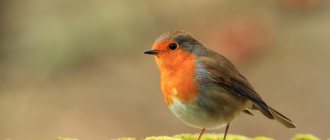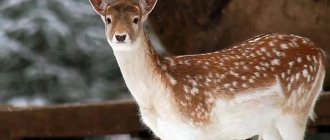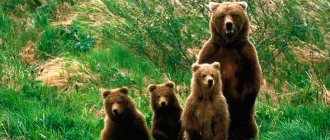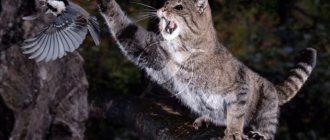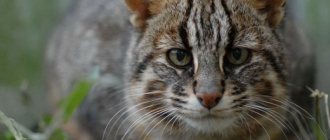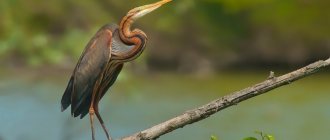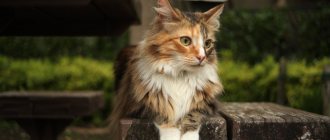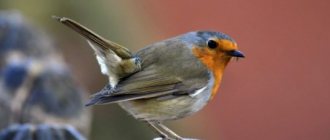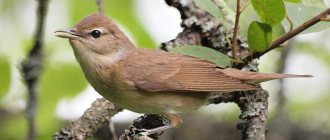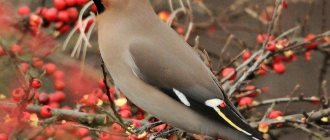The robin is a small bird of the flycatcher family of the passerine order. It has several names - it is often called robin, sometimes dawn or alder. The robin is known for its beautiful voice. Birds live near bodies of water in mixed and deciduous forests, overgrown parks and gardens. They live in the northwestern part of Africa, on the northern coast of the Mediterranean Sea, in Scandinavia, and western Eurasia. The bird got its name due to its bright feature - an orange spot on its chest.
Bright color is a feature of the robin
Types of robins
Robins (Erithacus) are a genus of birds from the flycatcher family.
three species of in nature :
- Black-throated Robin, Ryukyu Nightingale (Erithacus komadori);
- Robin (Erithacus rubecula);
- Japanese Robin (Erithacus akahige).
It is worth noting that only the last two species are described in detail; as for the black-throated robin, there is very little information about it.
What does a robin eat?
Eating is one of the key actions of any living creature. The diet of a robin would hardly please a human. Most often, birds eat centipedes, worms, spiders or beetles.
However, you can often see a feathered friend eating berries. Most of all, birds like blackberries, currants, and rowan. Interestingly, in nature it can be difficult for birds to find berries. Kind people passing by are always ready to help and feed their feathered friend.
Ornithologists highlight some consequences of this behavior:
- Birds get used to the changed diet. Interesting consequences can occur over many generations. It is possible that some of the robins that actively take food from people’s hands gradually get used to the change in the ratio between animal and plant food. It is unlikely that many people will want to feed a bird a worm. As a result, natural selection may take the path of creating more specialized representatives of robins that feed mainly on berries. However, this will happen only after many generations.
- Birds survive even if they find it difficult to get their own food. It turns out that people indirectly contribute to the preservation of those individuals that would not survive in the wild. Therefore, their genes are also passed on.
In all cases, we are talking about strengthening increased trust in people. The processes described above only work over a large number of generations and do not necessarily become fixed. However, the impact of humans on nature cannot be underestimated. If you want to contribute to changing the characteristics of robins, be sure to feed the bird the next time you see it.
Appearance of robins
Common Robin (Erithacus rubecula).
These songbirds are very modest in size. Their body length is from 15 to 16 centimeters. Weight of an adult robin: 16-18 grams. These birds have a small and thin beak, miniature but very tenacious legs. The plumage of robins is loose and quite soft; the feathers do not fit tightly to the body. This structure of the feather cover “plumps” the bird, but in fact it is smaller than it seems due to its fur coat.
The color of the plumage depends on the species: the common robin has olive-gray wings, tail and back, the chest and abdominal area are light gray, but the chest, throat and frontal part have a bright orange tint; As for the Japanese Robin, the upper part of its body is reddish, the lower part of the body is bluish-gray. Female robins can be distinguished from males only by a brighter spot on the chest (which is characteristic of males).
Population and species status
The total number of these birds in the world is more than 300 million individuals, with almost 80 percent of the population in the European part of the continent. In this regard, it should be noted that nothing threatens this small bird in our time. The bird is quite prolific, and the times when people caught them in order to hear their singing at home have sunk into oblivion. Despite this, in pet stores you can easily buy any bird to keep in captivity, but there are fewer and fewer such lovers, since it is now fashionable to keep a crocodile, poisonous snake, elephant or other exotic and sometimes very dangerous animal at home or reptile.
Voices of birds - Robin, or robin (lat. Erithacus rubecula)
Where do robins live?
Japanese Robin (Erithacus akahige).
The common robin (robin) lives in Europe, in addition, it lives in the Caucasus, Western Siberia, Asia Minor, and North-West Africa. The Japanese species of robins lives in China and Japan. The southern populations lead a sedentary lifestyle, while the northern populations make seasonal migrations to warmer regions.
The robin bird is distinguished by its individual approach to life, if one can say so about birds, this is expressed in everything: robins live alone, they even fly alone for the winter. These little birds fiercely protect their territory from the encroachments of others. Males define their territory, including by issuing vocal “notices” that “the place is occupied.”
In large cities in the north, robins can winter near human habitation.
The birds got the name robins for their loud singing in the morning: their trills are heard especially loudly at sunrise and sunset, but in general, robins sing all day long.
Traditions and legends about the robin
Even the ancient Celts and Germans associated robins with their gods. The bird was considered the messenger of the Sun, and later the messenger of the god of storm and thunder, Thor. If a robin made a nest, it was considered a good sign. Destroying robins' nests was a great sin and was severely punished.
Over time, robins became very popular. Wealthy Europeans and Egyptians kept them as pets. In the 19th century, stamps and postcards depicting the Robin became widespread in Europe. At the same time, a legend appeared that birds tried to save Jesus Christ and remove thorny thorns from his body. Therefore, on the front of their heads and chest they had a scarlet spot, symbolizing the blood of Christ.
The robin is often mentioned in the works of famous writers and poets, for example, in the Isle of Man lullaby “Ushag veg ruy”, the novel by J. Nesbø “Redneck”. There is a whole series of paintings about robins and fairy-tale creatures by artist John Anster Fitzgerald. The most famous song about robins in Russia is the work of VIA “Verasy” “Robins Hearing a Voice...”.
Robin breeding
A male robin sings in the spring forest.
Robins lay eggs twice a year. There are from 5 to 7 eggs in a clutch. Incubation of future chicks does not last long - about 13 - 14 days. After birth, for the first 12 days, the babies sit in the nest, their parents (both male and female) feed them. On the 13th day, the chicks make their first “exits” from the nest, however, they stay at a close distance.
Attitude towards people and singing of the robin
A distinctive feature of these birds is their singing. The morning “concerts” are sung by the males, entering after the black redstart, at the same time as the blackbird. They can continue chirping even late in the evening - they can be heard in parks at twilight. Males have a more varied “set of notes” than females, especially during the breeding season. Their song is considered one of the most beautiful; in winter, robins of both sexes sing.
Listen to the robin's voice
The musical bird has a good relationship with humans - it can even feed from hands. Often these birds stop at places where the earth is being dug up - in the loose soil they can find delicacies in the form of worms and beetles. In winter, they can even fly into people's homes in search of warmth. They can bask near unnatural light sources, providing an opportunity to admire their unusual plumage.
Despite such friendliness, it is not often possible to meet them at dachas outside the city. Well-groomed places are not suitable for them to lay eggs; they are lovers of natural “trash” - in woodlands you can see colorful birds, they love moss-covered stumps and undergrowth. And under no circumstances will this bird settle in clean and abundantly lit deciduous forests.
Enemies of robins in nature
Larger feathered predators are not averse to hunting these birds: falcons, owls, in addition, they attack robins, and their nests are also destroyed by predators such as forest cats, ferrets, foxes, stoats, martens, weasels.
Life in captivity is not a burden for robins: if they are properly cared for, they quickly adapt, get used to their owner and delight him every day with their ringing trills.
If you find an error, please select a piece of text and press Ctrl+Enter.
Natural enemies of feathered friends
The life of a robin is not easy. In the wild, a bird has to face a lot of enemies. The small size of the bird attracts predators who want to feast on the robin.
Some predators may even be attractive to humans. These include cats and cats. If a person meets a cat who wants to catch a robin and intervenes, a difficult moral choice is being made. Who should I help? Perhaps a robin? But then the cat will be left without food and, perhaps, will catch another bird.
Ornithologists and zoologists recommend not helping anyone in such cases, trusting in natural selection. Of course he is cruel and harsh. If everything is left to chance, the most trusting robins will die first. However, in nature, one species always eats another.
However, you can always carry some meat or sausage with you to treat the cat and, thereby, save the robin and satisfy the animal’s hunger. Unfortunately, this is not always possible to do.
But it's not just cats that threaten the health of robins. Among the predators there are other birds. For example, hawks, which love to eat robins. It becomes much more difficult to escape from such an enemy. You can't fly away, the hawk will catch up. Fortunately, in Russia, robins have significantly fewer natural enemies.
SINGING
Birds use their singing to mark territory and attract partners. In the spring, when male robins are looking for a female, they sing louder. Morning singing is primarily associated with marking territory.
Robins sing almost all year round. In late summer, during fledging, they sing much quieter than usual. From this period and throughout the fall, both adults and juveniles perform a quiet, more melancholy "autumn song", the main purpose of which is to mark winter territory. Males begin to sing their spring song as early as February. This song ends with the melodious ringing of silver bells. The robin sings especially well immediately after sunrise and sunset - hence the second name of this bird - robin.
Small birds that look like a song robin
The robin vaguely resembles a chaffinch. This is also a bird with an orange tail, similar to a sparrow. Similar indicators of size, body weight, and wide wingspan bring this bird closer in description to a robin. However, the finch is a member of another family (finches). He has different eating habits and characteristic differences in his lifestyle.
The small redstart can be unknowingly confused with a robin. The photo shows that these are red birds with gray plumage on the back, tail and wings, the size of a sparrow. The redstart has a similar lifestyle and habitat to the robin. These are representatives of the same family.
Bullfinch - the bird in the photo vaguely resembles the Robin in question. However, similarities can be seen in body structure and size. The habitat of bullfinches also shares similarities with the robin. But these birds have their own characteristics in their way of life, they have different feeding habits and are not distinguished by the same outstanding singing qualities as the robin, whose voice is sung by poets.
Photo of a finch
What bird nests look like: photo and description
Robin eggs can be found in nests located on the lower tiers of tree trunks, in cracks and niches with narrow spaces. The nests themselves are untidy, made of thin twigs and natural material. The robin's eggs should be safe. That is why the bird is looking for an obstacle in the form of a stone or a natural curtain to organize a nest. The base of the nesting site must be covered. At least that's what the robin thinks. A photo of the bird during the nesting period shows that the females have a very developed “maternal” instinct. In a year, a bird can give birth to two generations of offspring.
Drawing of a robin with chicks
Nutrition
These representatives of the flycatcher family fully correspond to the indicated status. After all, robins are known as insectivorous creatures. In addition to flies and mosquitoes, in the midst of a fertile summer, they tirelessly hunt for hordes of small beetles and insects, spiders, caterpillars, bedbugs, and happily eat snails and earthworms.
To search for prey, such birds do not need company, and therefore hunt, as they live, alone. Protein-rich foods are very suitable for bird bodies. But such animal food is not always available.
After all, as soon as the blessed sunny and warm days go away, robins have problems with protein nutrition. Therefore, in the fall they are forced to eat berries, of which there are huge quantities in the forests at this time, as well as seeds.
If the birds do not leave their native land for the winter, then they happily eat from the feeders that people build for birds during the harsh season. It’s also hard for them in the early spring, until the usual spring bustle of the insect kingdom comes to life. But soon grace begins again for the birds.
Birds of the continents Robin. Video (00:02:14)
The robin (robin) is a bird somewhat smaller in size than a sparrow, with an orange breast. Flies in forest undergrowth very low above the ground. Sometimes he stops for a moment, bends down (bows) and quickly flicks his tail. Makes a quiet, abrupt cry “tsik... tsik:”. When alarmed (in the presence of chicks), it emits a very quiet, gentle whistle. The singing is a ringing and chirping trill, beginning vaguely with some very drawn out sounds. In the evenings after sunset it often sings on the top of the spruce tree.
Appearance of the bird
The robin is a small bird, comparable in size to a sparrow. The weight of the male is 14-18 g, and the female is slightly larger, her weight is 14-23 g. The bird has long legs, a thin beak, and the body position is more horizontal than vertical. The color of female and male individuals differs only partially. The abdomen, feathers, back and back of the head are gray with different shades; The chest is reddish-brown, as is the neck, sides and front of the head. The abdomen is the lightest, closer to white-gray. Males have a more saturated color and a red-brown spot along the edge, and there is also a blue edging.
Old females do not differ much in color from males. Young animals that have just hatched do not yet have clear color outlines. They are more variegated in color: a combination of gray with red spots, but by autumn they become similar in color to adult individuals.
Lifestyle and habitat
The robin's habitat is extensive - the North Sea coast, Morocco and even North-West Africa. To the north it lives as far as Finland and Scandinavia, including Western Eurasia. In Russia, you can hear the singing of the Robin in the middle zone, and not only in the forests.
This bird chooses dense forests - it especially likes thickets of hazel and alder. They can also be spotted in overgrown groves of parks, and she tries to avoid pine plantings filled with sunlight.
Robins are not afraid of people and can settle near houses
They are not afraid of people, so they even settle in gardens if they like them. They prefer places with high humidity – close to bodies of water, for example.
The robin does not live with other birds , often starting battles for a good place. Males can fight among themselves for land, and the death rate in them is high - up to 10%. Adult individuals prefer a solitary lifestyle after dividing the territory; they rarely get along even with their own species. After migrating south, they return to their original places.
The robin prefers daytime activity and can sometimes be found at night near artificial light sources. Despite some similarities with other representatives of its family, this bird is distinguished by its habits: it moves with jerky movements, often leans forward. It prefers to perch on lower branches, unlike many small birds.
At the end of the 19th century, attempts were made to artificially breed this species in several countries - New Zealand, Australia and America. However, the robin did not take root in new places; a possible reason was the need for annual migration, because the robin is a migratory bird.
They migrate in late autumn and are among the first to return in spring - thick plumage allows the birds to comfortably tolerate low temperatures. Returning to their native lands in late March - early April, the males immediately begin singing, opening the breeding season. The chirping reaches its apogee by the middle of the second month of spring, because the first chicks appear already in May.
INTERESTING FACTS, INFORMATION…
- In England, postmen are called robins because of their red uniform. Robins were also associated with holiday cards.
- In Britain and central Europe, robins live near human settlements. In other European countries they are shot for sport or for food consumption.
- A third of all young robins die before the end of their first year of life. They are overtaken by predators or die of hunger, because they are unable to take care of themselves. A tenth of adult robins die defending their territory from enemies.
- The blackbird is the American equivalent of the robin.
What kind of bird builds a nest in a raspberry?
Garden
The robin belongs to the small songbirds of the passerine order of the thrush family, which today is better known as the robin.
The sonorous and melodic voice of these birds was once admired by many great poets from different countries, so their outstanding vocal abilities were captured in poetry more than once.
Their closest relatives are nightingales, while scientists currently know only two species of these birds: the Japanese robin and the common robin.
Character and behavior
The bird appears in early spring, even before buds appear on the trees. She immediately reminds of herself with her trills. Songs are heard all day long from sunrise to sunset. As time passes, when the first leaves appear on the tree branches, the robin will sing only in the morning and evening.
This bird is friends with humans and is not at all afraid of them; very often robins live right next to a residential building and when cold weather sets in, they can even fly inside . As for the proximity of the bird to its fellows, the situation is different. The Robin is a solitary bird that fiercely defends its nest. The male can be incredibly aggressive towards relatives. When fighting to protect their home, birds can fight so fiercely that up to ten percent of birds die in the conflict.
Key Features
Robins are much easier to see in photos than in real life. And the point is not that she leads a secretive lifestyle (although there is some truth here), but that she is extremely active.
The very first description of this species belongs to the pen of Linnaeus. Back in the 17th century, in his work “System of Nature,” famous among biologists, the scientist classified the robin, considering all its habits.
This is interesting! The scientific name is Motacilla rubecula, which includes the species name and the generic epithet (rubecula), which roughly translates into Russian as “little red.”
Birds live on average about 5 years, although they can live up to 12. But among young birds, mortality is very high, primarily due to aggression towards each other. In general, there is an opinion among ornithologists that if a robin chick survives its first year, then it has a high chance of dying at the ripe old age of 10 (or older).
No description would be complete without a story about how this bird sings. Listening to a robin is a pleasure; it is not for nothing that it is considered almost the most skillful songster! The bird begins to trill with the onset of dawn, during the day it is silent, and at sunset it again joins the general choir.
The song immediately stands out for its incredible purity of sound, skillfully alternating high-pitched whistles and melodic chirping.
In early spring, characteristic sounds can be heard almost all day long, but closer to summer, robins delight lovers of their trills only in the evening and in the morning.
Male Robin sings a song
